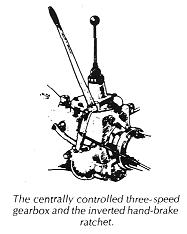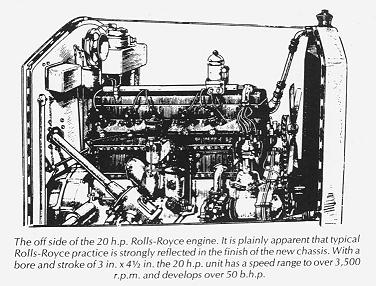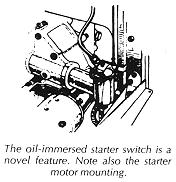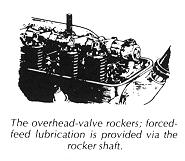From RROCA-info
THE NEW 20 h.p. ROLLS-ROYCE
Striking Departure from Practice of 15 Years
(from a 1922 edition of Motor)
When a concern that has built up a world-wide reputation on one policy decides to alter that policy after fifteen years' steadfast adherence to it, more than passing interest is attached to the change. The 40-50 h.p. Rolls-Royce chassis has been produced in numbers from year to year without its design having been altered in more than detail, and the suddenly announced introduction of an entirely new 20 h.p. chassis, to be sold alongside the older type, has naturally created no small stir in automobile circles.
We publish herewith the first complete, independent, and authoritative description of this new car, incorporating our own impressions of the chassis, together with carefully prepared illustrations, after a minute examination of all the detail features.
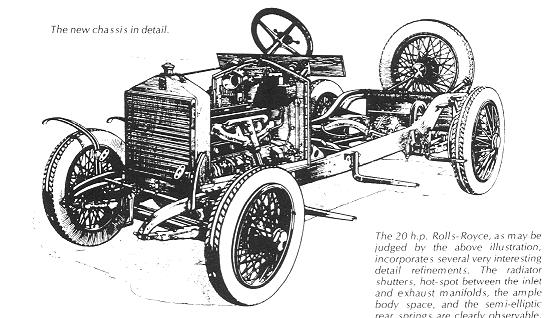
The existence of this smaller Rolls-Royce has been known to The Motor for some considerable time; in fact, we published photographs of a 20 h.p. Rolls-Royce car when it was in its experimental and test stages over a year ago. We are also able to give some general indications as to the performance of the car on the road.
In writing of this new 20 h.p. Rolls-Royce as a smaller car some qualification is needed. It is in no sense a "small" car as is usually understood, its appearance being large and imposing; it is only when one sees it alongside the 40-50 h.p. model that one appreciates the difference in size. The new chassis has a wheelbase of 10 ft. 9 ins., which is well above the average, and the body space is very large when compared with the overall length of the car, an arrangement made possible by the compactness of the new engine.
The chassis takes roomy, six-seater limousine coachwork without any suggestion of disproportion, and in its appearance the bold upstanding lines usually associated with cars of this make are maintained and well harmonized. The chassis price is GBP 1,100.
The outstanding features of this new Rolls-Royce chassis are its overhead-valved engine, centrally controlled three-speed gearbox, semi-elliptic rear springs, and the unit construction of engine, clutch, and gearbox. All these represent a total break away from previous Rolls-Royce practice. The remainder of the car reflects the 40-50 h.p. chassis in general layout, although, naturally, differences in several other details are observable. For instance, on the 20 h.p. car one ignition system (battery) only is provided, the mixture control is on the dash instead of on the steering wheel, there is no cut-out on the silencer and no auxiliary oil tank is fitted; all of which features are prominent on the 40-50 h.p. model.
Dealing first of all with the power unit, the 20 h.p. Rolls-Royce engine is of the monobloc detachable-headed overhead-valve type, built up in a unit with a single-plate dry clutch and gearbox, the three components, however, being separate in so far as lubrication is concerned. The cast-iron cylinder block is made separately from the crankcase; on its near side it incorporates vertical tunnels through which run the push rods to the overhead valves; on the off side the casting is left open and the water jacketing completed by means of flat plates fixed by studs, this arrangement allowing for proper distribution of the metal in the process of casting.
The detachable head is also a single, close-grained iron casting, the joint between it and the cylinder block being made by a copper-asbestos gasket, water passages being provided adjacent to the bores of all cylinders instead of the one single connection that is employed by some manufacturers of this type of engine.
The overhead-valve rocker gear is mounted on the detachable head, and is in turn covered by an easily removable casing normally held in position by three milled nuts. This casing carries the ignition coil which is well out of the way of oil, heat and moisture in this position and also tubes through which run the high-tension leads.
On the near side of the cylinder block are mounted the external inlet and exhaust manifolds. Mixture from the carburetter, which is mounted on the off side of the engine, runs through a passage case in the cylinder block into the inlet manifold, and almost immediately comes into contact with a hot-spot that is formed by a surface joint between the junctions of the inlet and exhaust branch leads. This joint is intended never to be broken. The manifolds are specially treated to prevent them from assuming a rusty external appearance due to heat - a commendable feature.
As to the disposition of the various components, the gear-driven dynamo is spigoted into the timing case on the near side, the vertical distributor for the ignition system and the centrifugal water pump being driven in tandem on the off side. The camshaft is on the near side, being, of course, enclosed in the crankcase.
The Internal Parts
The internal parts of this engine are particularly interesting. At the outset it may be mentioned that it is a high-efficiency unit capable of giving off well over 50 b.h.p.; its compression ratio is 4.6 to 1, and it has a useful speed range of between 150 r.p.m. and 3,500 r.p.m., speeds which approximate to 3 m.p.h. and 65 m.p.h. on top gear. The crankshaft, which has hollow crankpins, is mounted on seven white-metal bearings to ensure rigidity, and is provided at its forward end with a vibration damper of the usual Rolls-Royce plate type. The whole of the timing gear is of helical-toothed pinions. The camshaft is also rigidly mounted in multiple bearings to prevent whip.
The valve gear is of outstanding interest, and, in view of recent controversy pro and con overhead valves, its layout should be considered in conjunction with the lubrication system. The sump holds a gallon of oil, this lubricant being circulated under pressure by an immersed pump to the main bearings, a branch lead serving to feed the valve and timing gear. An external oil pipe runs to the hollow shaft which are mounted on the rockers of the overhead-valve gear. These rockers are drilled and then plugged at their ends so that oil circulates on their rocking surfaces and also along their arms, and thus the end of the valve stems and also the ball and socket joints between the tops of the push rods and the ends of the rockers are supplied with lubricant under pressure. To some extent, therefore, an oil-cushioning effect is obtained, making for silence.
An interesting feature in connection with the Rolls-Royce valve gear is the fact that the valve clearance adjustment is provided on the tappets instead of on the rockers, access to this adjustment being afforded by two detachable plates on the near side of the cylinder block casting. It is observable that the push rods are very slender in section, and the whole valve gear is light, although, of course, adequately strong preventing any floating of the valves at high engine speeds. The normal valve clearance is three-thousandths of an inch, and the valve lift is five-sixteenths of an inch.
It may here be mentioned that the valve seats in the cylinder head are water cooled to prevent distortion, and, in order to prevent the oil which naturally is present on the upper side of the detachable head, from finding its way down the valve stems, felt washers are fitted inside the valve springs, these latter being fixed by the ordinary cone and cup method.
Turning now to the pistons, these are of aluminium, and carry three rings above the gudgeon pins, and their skirts are also split to prevent slap at low speeds when cold. The gudgeon pins are pinned into the pistons, and are lubricated under pressure. One of the piston rings acts as a scraper, and we understand that the oil consumption of the new Rolls-Royce engine is particularly light. The overall engine layout is notable in that it provides for a combustion head shape that is in keeping with the latest ideals, the head being almost circular in plan, slightly curved in section, and the points of the K.L.G. sparking plugs, which are inserted at an angle, are close to the inlet ports.
The unit incorporates several small but important details that are worthy of more than passing comment, particularly as regards the carburation and ignition. The carburettor is a modified pattern of that which is fitted to the 40-50 h.p. Rolls-Royce, the controlling piston being vertical instead of horizontal. It has two adjustable jets controlled from the dashboard, and it also is provided with what is fundamentally a separate carburettor for starting. When the main butterfly throttle is shut and the small lever on the dash is turned, this carburettor is put into communication with the induction pipe, and provides a supply of rich but properly vaporized mixture that is calculated to ensure an easy start from dead cold.
Auto-controlled Ignition
The governor-controlled throttle, which is such an outstanding feature of the 40-50 h.p. Rolls-Royce, is not fitted.
Particularly interesting is the fact that the crankcase is connected up by a half-inch bore pipe to the main air inlet, so that crankcase fumes are absorbed by the engine, preventing them from reaching the passengers in the car; at the same time, to some slight extent upper cylinder lubrication is provided.
The ignition system is by battery and coil only, and undoubtedly the choice of this feature by such a well-known designer as Mr F.H. Royce will go far towards popularising it in this country. The distributor is provided with a spark advance and retard range of 35 degrees from the steering wheel control, but, additionally, it is centrifugally controlled so that no matter in what position the ignition advance and retard lever may be placed, a self-adjusting 12-degree advance and retard is automatically afforded, according to the speed of the engine. This is a very clever feature, and makes for elasticity of performance which is independent almost of the skill of the driver.
As regards the cooling system, 3� gallons of water are contained in the system, and radiator shutters will probably be fitted as standard; either hand or thermostatically controlled. The four-bladed fan has its shaft spring loaded, so that the Whittle driving belt is always in correct tension, and a thermometer is provided on the dashboard, its temperature-indicating tube being fitted to the rear end of the cylinder block, so that it is the actual heat of the water in the cylinder jackets that is indicated and not that of the radiator. The shutters as at present fitted are controlled from the dash, and are of the horizontal slit type.
The dynamo is arranged so that it gives a big output of current at low speeds, gradually decreasing as the r.p.m. mount up, so that overcharging of the batteries is prevented when on tour, and an adequate supply of current is maintained in town. The six-volt accumulators, it may he mentioned, are slung inside the chassis at the rear, all the wiring is run through aluminium tubes wherever possible, and it is of the single-pole type, this making for sturdier construction and less likelihood of short circuits. The starter motor, which, like the rest of the electrical equipment, is of Rolls-Royce manufacture is fitted low down on the near side of the crankcase, its pinion engaging with teeth cut on the flywheel - another departure from previous Rolls-Royce practice. This pinion, incidentally, has an overhang bearing which prevents whip and the development of noise.
The starter-controlling switch is very ingenious. Mounted on the near side of the chassis, at the bottom of the dashboard, is what appears to be a vertical aluminium tube about 4 ins. long. This is kept filled with oil. The contact surfaces fur the starting current are mounted inside it and are thus immersed in oil, which prevents sparking and prevents any danger of fire. The switch itself is operated by a neat pedal situated on the floorboards, where it is not quite so well out of the way of the passenger's feet, perhaps, as it might be.
The Transmission
From the engine the drive is taken to the gearbox through a clutch which consists of a single steel plate, working "dry", between two Ferodo-lined surfaces. This is very light in action and as the inertia of the clutch shaft is small, gear-changing should be particularly easy and delicate. The gearbox is mainly notable for its compactness. It holds a half a gallon of oil, the layshaft being mounted underneath the mainshaft and all the bearings are particularly well arranged to provide the utmost stiffness, so that both long life and silence should be assured.
The centrally situated gear lever, incidentally a feature which one frankly did not expect to find on a Rolls-Royce, is provided with an invisible gate and an interlocking device which ensures that two gears cannot be meshed at once, and it works in the reverse manner to that of most centrally controlled three-speed cars, first gear being towards the driver and back, second being across the gate and forward, and top speed back to the left. There is no stop to prevent the reverse gear teeth being unintentionally kissed.
The mounting of the power unit in the chassis is very ingenious. At the front of the engine there is a neat U-shaped sub-frame made up of tubes. This is connected to the chassis through a central bearing on the front cross-member and is bolted to two arms on each side of the engine. At the rear two tubes extend horizontally from the aluminium flywheel casing and are coupled by socket joints to the chassis sidemembers. Thus perfect three-point suspension of the engine is obtained, absolutely preventing any possibility of trouble through whatever chassis flexion may take place on very bad roads.
Three standard back axle ratios are provided, the normal one giving 4.28 to 1 on top, 6.98 to 1 on second, 13.57 to 1 on first, and 18.40 to 1 in reverse. This is with a gear reduction of 14 to 60 on the final drive and represents the ratio suitable for an open four-seater. With standard tyres this gives 22-23 m.p.h. at 1,000 r. p. m. of the engine.
Undoubtedly the rear portion of the new 20 h.p. Rolls-Royce chassis is fully as interesting as the engine, for Messrs. Rolls-Royce have fitted cantilever rear springs for so long that their change to semi-elliptic is particularly noticeable, especially when these are fitted on the Hotchkiss drive principle so that both torque and drive strains are absorbed by the top spring leaves themselves. There is no torque tube or torque rod, the hollow propeller shaft being exposed: it is provided with sliding block universals at each end.
The rear springs are long and are arranged so that they lie almost flat when under load; they are undershackled at their rear ends and are slung underneath the axle. Particular care apparently has been taken to ensure that the unsprung weight of the back axle is as low as is possible. Thus the differential casing is of aluminium, the axle tubes being of steel, and the axle is, of course, of the full-floating type. The outside casing is braced by a rod running between the spring pads and underneath the differential casing.
Both brakes, which are cable-operated through the well-known Rolls-Royce differential-type compensating gear, are situated side by side in wide and unribbed drums on the back wheels, the shoes being aluminium lined with Ferodo. It has for some considerable time past been the aim of designers to obtain really silent brakes and Messrs. Rolls-Royce Ltd., had adopted the system of bolting an asbestos circular pad around the brake drums, this deadening any ring and practically eliminating all noise. Ample brake adjustment is allowed both on the pedals and in the cables.
The detachable wire road wheels are of Dunlop manufacture and are fitted with straight side Dunlop cord tyres as standard, these having proved very satisfactory under test, the size being 32 in. by 4 in. A 14-gallon petrol tank, provided with a side filler and gauge, is slung at the rear of the chassis, which is, it may be mentioned, somewhat upswept to give the back axle ample movement, and the spare wheel carrier consists of three triangulated tubes and a cradle, which carry the wheel athwart the chassis at the rear.
High-grade Steering
The steering gear is by the well-known Rolls-Royce worm and nut type, with springloaded drag rod to ensure delicacy of control. Constant action, friction-type Trufault shock absorbers are provided on the front axle, those at the back being of Messrs. Rolls-Royce Ltd., design and manufacture, and are so arranged that they act progressively, exerting a greater damping effect when the axle moves far from its normal position than is the case when the movement is only slight, so that any suggestion of harsh springing at low speeds should be prevented.
The steering lock on the car is 36 degrees to the right and 41 degrees to the left, which gives a minimum lefthand turn of 20ft. 6 ins. The weight of the chassis "dry" is 2,020 lb., and in order that the total weight of the car shall be as light as is possible without sacrificing strength, arrangements are provided for fitting the body on to platforms on the outside of the chassis, thus eliminating the need for heavy crossmembers in the coachwork. This method also ensures low passenger seats in the body - a very commendable feature.
In inspecting the chassis one cannot help but be impressed by the delicacy of the detail work and the neat refinements incorporated. For instance, the vacuum tank situated on the dash is of a very large capacity allowing the engine to be run for long periods on full throttle without fear of petrol starvation. The fuseboard is particularly accessible, and all the wiring is coloured. The Enots grease gun lubrication system is adopted throughout the chassis, dispensing with grease cups. The springs are, of course, equipped with gaiters as standard, and one can safely say that an owner-driver would have no trouble whatsoever in keeping this new Rolls-Royce up to concert pitch. The control rods for the ignition and carburetter are slender and incorporate ball-joints wherever necessary, and the dashboard is very daintily arranged.
